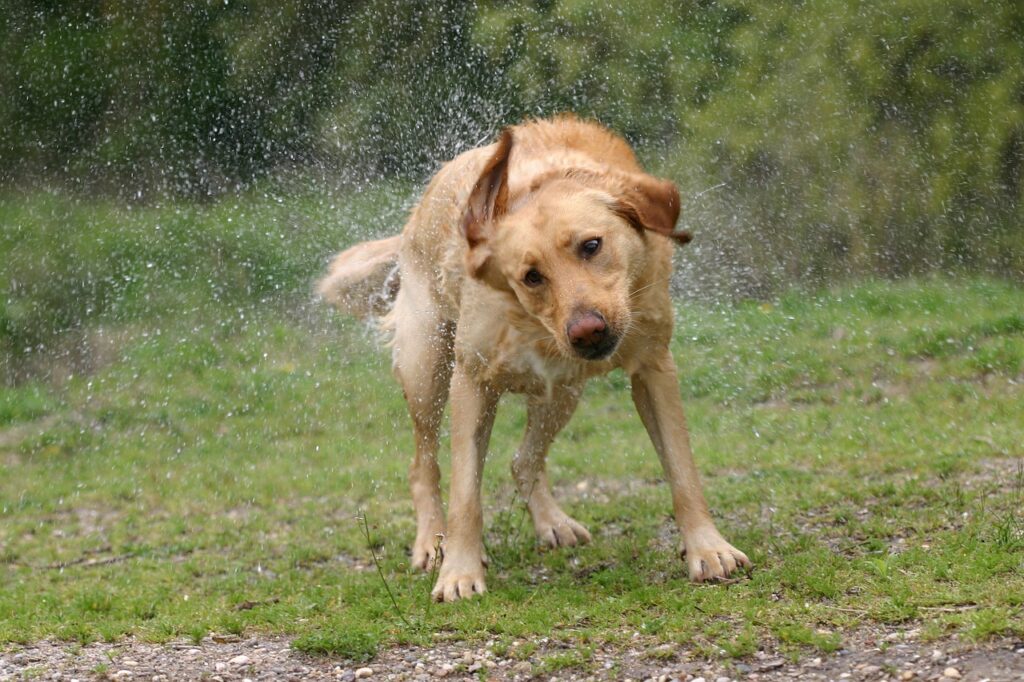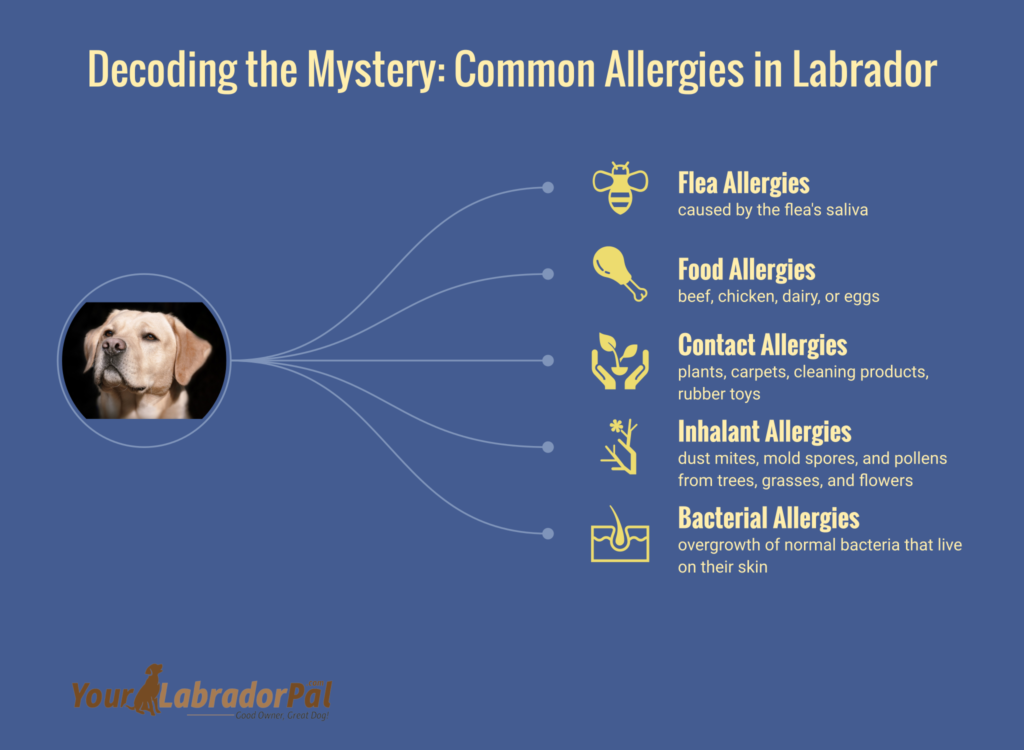What Are Labradors Allergic To? A Comprehensive Guide To Canine Allergies
Have you ever noticed your furry friend scratching themselves or suffering from frequent ear infections? As a Labrador parent, it can be a worrying sight to see. You may have already noticed that your loyal companion is prone to allergies. But what are Labradors allergic to? Understanding the causes of your best friend’s allergies can help you to prevent further discomfort and promote a happier, healthier life for your beloved pup.
In this blog, we will delve into the common allergens that these adorable breeds are susceptible to. So, let’s start understanding more about what makes our fluffy friends itchy and scratchy!
Understanding Canine Allergies
If you’re a pet parent, you may have noticed that your furry friend is excessively scratching, licking, or biting particular areas on their body. These behaviors can be an indication that your dog has allergies.
So, how do allergies work in dogs? When a dog’s immune system overreacts to a particular substance, such as pollen, dust mites, food, or flea bites, these allergens trigger a cascade of reactions in the body, leading to allergy symptoms. In some cases, the allergic reaction may be immediate; in others, it may take several hours or days to manifest.
Some common symptoms of allergies in dogs include:
1. Itchy Skin – Persistent itching is one of dogs’ most common symptoms of allergies. Your furry friend may scratch, lick, or bite their skin excessively, leading to redness, swelling, hot spots, and hair loss.
2. Ear Infections – Dogs with allergies are prone to ear infections characterized by redness, irritation, discharge, foul odor, and shaking of the head.
3. Digestive Issues – Some dogs may develop gastrointestinal problems, such as diarrhea, vomiting, flatulence, or constipation due to food allergies.
4. Respiratory Problems – Dogs with allergies may also exhibit signs of respiratory problems, such as sneezing, coughing, wheezing, or shortness of breath.
5. Behavioral Changes – Allergies can make dogs feel uncomfortable, restless, and irritable, leading to changes in their behavior, including decreased appetite, lethargy, and aggression.
Common Allergies in Labrador Retrievers
Labradors are known to be particularly prone to various allergies. Here are some common allergens that cause allergic reactions in Labradors:
Flea Allergies
Flea allergies, also known as Flea Allergy Dermatitis (FAD), are quite common in Labrador Retrievers. This allergic condition is not caused by the fleas themselves but rather by the flea’s saliva. When a flea bites a dog, it injects its saliva into the skin. For dogs with FAD, the immune system overreacts to the proteins in this saliva, triggering an allergic reaction.
The main symptom of FAD in Labradors is intense itching, which is usually concentrated around the base of the tail, but can also affect the rest of the body. Your Labrador may scratch, bite, or chew at these areas incessantly. This constant irritation can lead to hair loss, redness, and even open sores or “hot spots” if left untreated. These hot spots can become infected, causing further discomfort for your pet.
Another sign of FAD is the presence of flea dirt (flea feces that look like small black dots) on your dog’s coat. However, it’s important to note that not seeing fleas doesn’t rule out FAD. Some dogs are so allergic that a single bite can cause symptoms, and the offending flea may be long gone.
Food Allergies
Food allergies are quite common in Labrador Retrievers and can cause discomfort for your furry friend. When a Labrador has a food allergy, it means its immune system mistakenly identifies a particular food ingredient as harmful and launches a defensive response. This reaction can cause various issues, from skin conditions to gastrointestinal problems.
Common food allergens for Labradors include proteins like beef, chicken, dairy, or eggs and complex carbohydrates such as corn, soy, and wheat. These are commonly used ingredients in many commercial dog foods, so pinpointing the exact cause of the allergy can be challenging.
If your Labrador has a food allergy, you might notice them itching or scratching more than usual. They may develop red, inflamed skin or suffer from recurring ear infections. Gastrointestinal signs can also occur, including vomiting and diarrhea. In some cases, they may experience loss of appetite and weight loss.
Contact Allergies
Contact allergies, while less common than food or flea allergies, can still be a significant issue for Labrador Retrievers. This type of allergy occurs when your Labrador’s skin directly reacts to certain substances or materials it comes into contact with.
Common triggers for contact allergies in Labradors can include various substances found in their environment, such as certain types of grass, plants, carpets, cleaning products, rubber toys, and even certain fabrics like wool. Metals, particularly nickel, found in some dog tags or collars, can also cause contact allergies.
The symptoms of contact allergies typically manifest as skin irritations in the areas that have been in direct contact with the allergen. You might notice your Labrador excessively licking, biting, or scratching at certain areas. These areas may appear red, inflamed, or even have hair loss. The most common areas affected are usually the body parts with less hair and are more likely to come into contact with allergens, such as the belly, feet, or muzzle.
Inhalant Allergies
Inhalant or atopy or airborne allergies are quite common in Labrador Retrievers. This type of allergy happens when your Labrador’s immune system overreacts to common environmental substances that are inhaled or come into contact with the skin.
Common inhalant allergens for Labradors include house dust mites, mold spores, and pollens from trees, grasses, and flowers. Even indoor dogs aren’t safe from these allergens, as dust mites and molds can be found in any home, and outdoor allergens can be easily brought inside on clothing or shoes.
Symptoms of inhalant allergies usually involve skin irritations, leading to excessive scratching, licking, or chewing. These symptoms often worsen during certain seasons, like spring or fall, when pollen counts are high. However, some dogs may have year-round symptoms if they’re allergic to indoor allergens like dust mites. You might notice your Labrador focusing their scratching on their feet, belly, folds of the skin, and ears – places where pollen and dust can settle.
Diagnosing inhalant allergies can be a bit tricky, as the symptoms can be similar to other types of allergies. Veterinarians usually rely on the dog’s history, symptoms and may perform specific allergy tests to identify the offending allergens.
Bacterial Allergies
Bacterial allergies can occur in Labs due to an overgrowth of normal bacteria that live on their skin. This overgrowth can lead to itchy and inflamed skin, which can cause discomfort and irritation for our beloved puppies.
One of the most common signs of bacterial allergies in Labradors is excessive scratching and licking of the affected areas. You may also notice a foul odor coming from your dog’s skin.
Treatment and Management of Allergies in Labradors
As a pet owner, watching your pup suffer from allergies can be difficult. Fortunately, various treatment and management options are available for Labradors with allergies.
Dietary Changes and Hypoallergenic Foods
The primary treatment for food allergies in dogs is avoidance. This means identifying and eliminating the problematic food ingredient from your dog’s diet. This is often achieved through an elimination diet, which involves feeding your dog a simple diet of foods they have never eaten before, then gradually reintroducing other foods to see which ones trigger a reaction.
Now, let’s talk about hypoallergenic foods. The term “hypoallergenic” essentially means “less likely to cause an allergic reaction.” Hypoallergenic dog foods are designed with this in mind, often made with novel proteins (like venison or duck) and carbohydrates (like sweet potatoes or peas), which your dog’s immune system is less likely to react to. Some hypoallergenic diets also use hydrolyzed proteins, where the protein is broken down into such small pieces that the immune system doesn’t recognize it as an allergen.
Switching to a hypoallergenic diet can be a game-changer for a Labrador with food allergies. It can significantly reduce their symptoms and improve their overall quality of life. However, it’s important to remember that every dog is unique, and what works for one dog might not work for another. Therefore, it’s always best to consult with a veterinarian before making any major changes to your dog’s diet. They can guide you in choosing the right diet for your Labrador based on their specific needs and sensitivities.
Medications and Allergy Shots
Medications can play a big role in managing the symptoms of allergies in Labradors. Antihistamines, for example, can help reduce itching and inflammation. Your vet might recommend over-the-counter antihistamines like Benadryl, but always consult with them first for the correct dosage and to make sure it’s safe for your specific pet.
Corticosteroids are another type of medication that can be used to control allergy symptoms. They effectively reduce inflammation and suppress the immune system’s response to allergens. However, they should be used cautiously due to potential side effects, especially long-term use.
For dogs with severe or chronic allergies, a type of medication called immunomodulatory drugs may be prescribed. These medications work by modulating or adjusting the immune system’s response to allergens.
Now, let’s talk about allergy shots, or what’s officially known as immunotherapy. This treatment involves injecting small amounts of the allergen under your dog’s skin over some time. The goal is to desensitize the immune system to the allergen, reducing its reaction to it.
Immunotherapy is a more long-term solution and can be very effective, especially for inhalant allergies. It’s typically recommended for dogs whose symptoms are severe, last for more than 4-6 months out of the year, or don’t respond well to other treatments.
Remember, while medications and allergy shots can greatly improve your Labrador’s quality of life, they’re not a cure for allergies. Managing allergies is all about controlling symptoms and making your dog as comfortable as possible.
Topical Treatments
Topical treatments can be a great way to manage allergies in Labrador Retrievers. These treatments are applied directly to the skin and can provide immediate relief from allergy symptoms, especially those related to skin irritations.
Let’s start with medicated shampoos and conditioners. These products are designed to soothe inflamed skin and alleviate itching. They often contain ingredients like oatmeal, aloe vera, or hydrocortisone, known for their soothing properties. Regular bathing with these products can help wash away allergens from your dog’s coat and skin, reducing irritation.
Next up, we have topical creams and ointments. These are typically applied to specific areas of the skin that are affected by allergies. For instance, hydrocortisone creams can help reduce inflammation and itching. There are also topical sprays containing antihistamines or corticosteroids, which can quickly relieve allergy symptoms.
Your vet might prescribe a stronger topical medication for Labradors with severe skin conditions due to allergies. One example is Animax Ointment, which combines a corticosteroid, an antifungal, and an antibiotic to treat inflammation, control itching, and prevent secondary bacterial infections.
Allergy balms and natural remedies can also be useful. These products are often made with natural ingredients like coconut oil, shea butter, or beeswax and can help soothe and protect irritated skin.
Flea Prevention and Treatment Strategies
Fleas are extremely common in dogs, especially during the warmer months of the year. Not only do they cause a lot of itching and discomfort, but they can also cause or worsen allergies in Labradors.
Fortunately, there are several strategies you can use to prevent and treat flea infestations. The first step is to ensure your pet is on a regular flea preventative. This should be done year-round, even in colder climates.
If your Labrador comes into contact with fleas, you’ll want to start treating them immediately. There are many excellent products available that can help eliminate existing infestations and prevent future ones. Some of these include topical treatments, sprays, shampoos, and even oral medications.
In addition, you’ll want to thoroughly clean your dog’s bedding and vacuum your home frequently. This will help eliminate any fleas or flea eggs that might have been left behind. Additionally, wash any other items that your pet may have come into contact with (such as blankets or toys).
Environmental Changes
Environmental allergies are often very difficult to manage because there’s no way to avoid exposure. However, there are some changes you can make in your home and yard that may help reduce your Labrador’s symptoms.
First, try to minimize the amount of dust particles in your home by using HEPA air filters and vacuuming frequently. Additionally, wash your pet’s bedding on a weekly basis.
If you have carpets, they can also be a source of allergens. Consider replacing them with hardwood flooring, or at least get an anti-allergen carpet cleaner to help reduce the amount of dust particles in your home. Finally, try to keep windows and doors closed as much as possible to limit outdoor allergens from entering your home.
For outdoor allergies, try to limit your Labrador’s exposure to grasses and weeds by avoiding areas that may be heavily infested with these allergens. Keep your yard free of debris so that it doesn’t become a breeding ground for fleas and other pests.
Finally, if you have an especially sensitive pet, you may want to consider investing in an air purifier. These devices can help reduce the amount of allergens in your home, making it much more comfortable for your Labrador Retriever.
Frequently Asked Questions
Q: What are the most common Labrador food allergies?
The most common allergens for Labradors include chicken, beef, and lamb. Other culprits could be soy, wheat, dairy, and eggs. While each dog is unique and may have different triggers, paying attention to their behavior after feeding and seeking veterinary advice if you suspect a food allergy is important. After all, a happy and healthy Labrador is a happy and healthy household.
Q: Is there home remedies for Labrador skin allergies?
There are a few home remedies that can help alleviate your furry friend’s allergies. Things like fish oil supplements, oatmeal baths, and coconut oil can all soothe irritated skin. Additionally, try switching up their diet. Sometimes, certain foods can trigger allergic reactions in dogs. With some research and experimentation, you can help your Labrador get back to doing what they do best.
Q: When do seasonal allergies affect Labradors?
It typically begins in the spring and can last through the fall. However, this varies from dog to dog. Some may have dog allergies that start earlier or last longer than others. Again, it’s important to pay attention to your Labrador’s behavior during these months so you can identify if they’re having an allergic reaction or symptoms of allergies. With the right management plan and veterinary care, your Labrador can enjoy the outdoors without any issues.
Q: Do other dog breeds suffer from allergies?
Many other breeds can get allergies too! Some pooches with a high risk for allergies include Bulldogs, Pit Bulls, German Shepherds, and Pugs. So, if your furry friend is showing any signs of allergies, no matter the breed, it’s essential to take them to a veterinarian and find the best treatment plan for them.
Q: What is the best way to prevent allergies in Labradors?
One of the best ways is through their diet. Feeding your Lab high-quality, hypoallergenic dog food can make all the difference. Additionally, be mindful of any potential allergens in your home, such as dust or pollen, and regularly clean your pup’s living space. And, of course, regular vet check-ups can help catch any potential allergies early on. By taking these preventative measures, you can keep your furry family member healthy and allergy-free!
Final Words
As a labrador owner, I’ve learned that being attentive to your pup’s diet and daily routine is crucial in preventing or managing allergies. Acquiring knowledge about the most common allergens can also help us stay informed and proactively avoid them.
It’s important to keep in mind that allergies can severely impact our Labrador’s quality of life, causing discomfort and pain. Therefore, understanding their symptoms and seeking veterinary advice is the best way to keep them healthy and happy.
Overall, while I learned a lot about what to do and avoid when it comes to labrador allergies, what matters most is that we love and care for our furry friends, giving them the attention and care they deserve.










